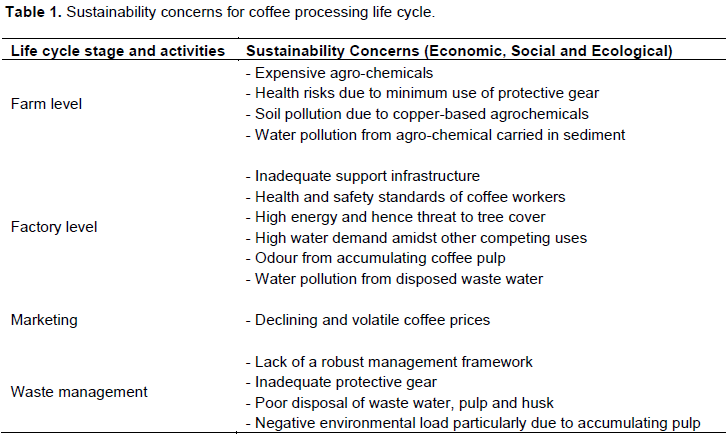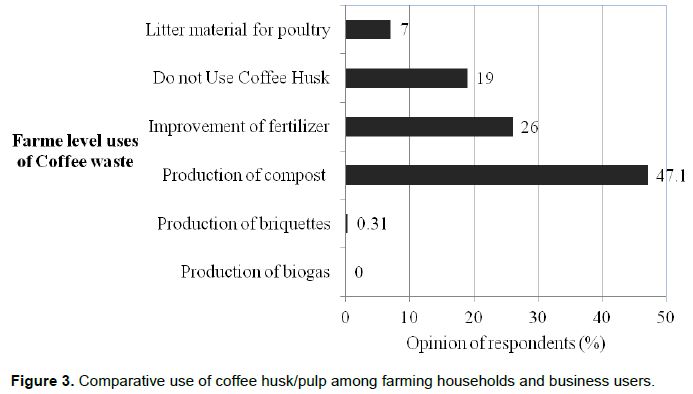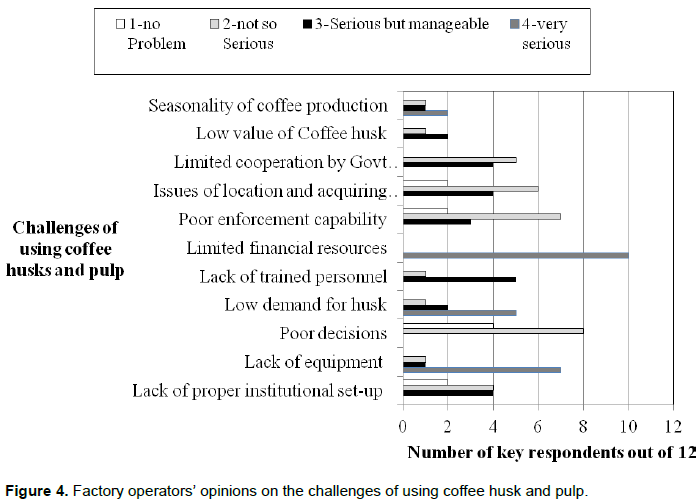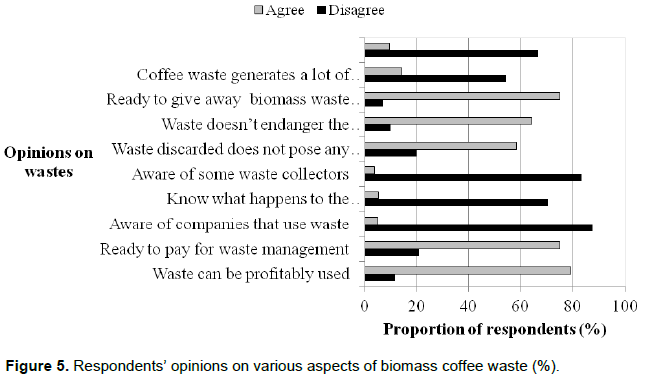ABSTRACT
Coffee processing is associated with various sustainability challenges largely due to high water and energy demand, biomass waste generation and lately low returns to farmers. The number of farmers actively involved in coffee production in Kenya is declining. Despite this trend, this paper reports on the potential of maximising benefits to coffee farmers by using coffee processing wastes (pulp and husks) in energy and agricultural services. A survey research design targeting six small to medium scale factories selected based on common criteria and 252 respondents was used. Results showed that about 210 tons of unprocessed coffee was received cumulatively in all the six factories surveyed per year. Processing generated approximately 51% biomass waste from the total input. Direct disposal of this waste to land contributes to direct environmental pollution. Accumulation of coffee husks and pulp was attributed to low awareness of the various uses these wastes have been successfully put elsewhere in the world. Opportunities for increasing benefits to farmers and reduced environmental loads exist in the conversion of coffee husks into branded briquettes for domestic energy supply, and pulp into fortified organic fertilizer for increased land productivity. Kiambu County government needs to invest in these two options through technological innovations and commodity specific extension service that is aligned to global sustainable production and consumption patterns.
Key words: Coffee processing biomass wastes, sustainability benefits.
Coffee production in Kenya has been on the decline since 2009, a trend attributed to among others factors erratic weather, conversion of coffee land to real estates and high costs of inputs (Republic of Kenya, 2013a). However, estimates from the International Coffee Organization (2010) indicate that the total production of coffee from exporting countries increased in years 2000 and 2010 from 112, 991,000 and 133,065,000 bags, respectively with Kenya exporting 51,000 metric tons of coffee beans in 2010 alone. In Kenya, more production is being witnessed in smallholder systems as large plantations, especially those in proximity to the city Nairobi, give way to real estate development. Despite this trend, projections indicate that Kenya’s coffee production in 2016/2017 will increase to 700,000 bags up from 600,000 bags in 2015/2016 (USDA-FAS, 2016). Fluctuations in global market prices have nevertheless often been detrimental to small-scale farmers. In addition, organic waste generated from coffee processing and other crop specific postharvest processes are challenges that need to be addressed in-line with environmental sustainability concerns (Republic of Kenya, 2013b), hence the gist of this paper.
The main sustainability concerns in coffee processing are as a result of intensive use of pesticides and poor disposal of waste products. About 99% of the biomass waste produced, mainly untreated pulp and husks is discarded on land. Further coffee processing consumes high quantities of water and energy. According to Shitanda (2006), over 200,000 tonnes of pulp at 77% moisture content and 2,300,000 litres of polluted water are released into the environment everyday in Kenya. This is equivalent to pollution caused by 1.2 million people per day. On average 45.5 kg of green coffee requires between 1000-2000 L of water, 12.5 kWh of electricity and 0.07 cum of firewood for processing (Instituto del Cafι de Costa Rica -ICAFE, 2006). A survey of rivers between Nairobi and Thika towns in Kenya showed that they were all polluted with coffee waste with Biological Oxygen Demand (BOD) levels of more than 100 mg/l. The unpolluted rivers had BOD of 4 mg/l (Wrigley, 1988). Although a river of 10 mg/l is considered significantly polluted, the maximum allowable limit of effluent discharge into the environment is 30 mg/l (BOD 5days at 20°C) according to Kenya’s National Environment Management Authority (NEMA) Standards (Republic of Kenya, 2006). In pursuit of sustainable goals 6 and 12 (https://sustainabledevelopment.un.org) such large volume of water can be treated and reclaimed for other uses particularly in a water scarcity nation like Kenya (http://www.unep.org/dewa/vitalwater/article83.html), this waste water can be treated and reclaimed for other uses. Establishing facilities capable of improving the overall efficiency of coffee processing with focus on waste reduction is costly and may not be affordable to majority small-scale farmers. Opportunities for bulking raw material lies with factory level operations. Studies elsewhere indicate that coffee husk and pulp can be used as organic fertilizer, domestic fuel, and for biogas generation (Ulloa et al., 2003; Pandey et al., 2000; Kaliyan, 2009, Sanchez et al., 1999; Sorby, 2002), thus reducing the burden of waste disposal.
Although coffee processing has significant sustainability challenges, major coffee producing nations such as Brazil have made significant efforts to treat coffee waste water and utilize solid biomass waste, thus contributing to reduced environmental pollution and burden on virgin resources (Cofie et al., 2005; Padmapriya et al., 2013). Further, since the middle of this century, efforts have been made to develop methods for coffee waste treatment and management, and also its utilization as a raw material for the production of vinegar, biogas, caffeine, pectin, peptic enzyme, protein, compost and feed for producing polysaccharides and mono-saccharide. While multiple benefits from using and adding value to agricultural wastes are appreciated in densely populated nations like India (Sindhu and Shehrawat, 2015), a key adoption limitation in most developing countries is lack of awareness and lack of detailed regulations on crop specific agricultural wastes management for environmental protection (Khanh and Thanh, 2010). Kenya lags behind in this regard, which translates into missed opportunities towards increased environmental and socio-economic benefits to farmers. Availability of this knowledge implies that new extension approaches that address the entire crop value chains with farmers owning key aspects thereof like is the case in soil improvement demonstration plots by the Alliance for a Green Revolution in Africa (AGRA) and International Institute of Rural Reconstruction (IIRR) (2014) may benefit coffee systems. Milling sites can be converted into extension service demonstration sites (plots) for maximized benefits from coffee wastes. For instance, the Gusii Coffee Farmers Co-operative Union is among progressive millers in Kenya who have embarked on processing of coffee husks into branded charcoal briquettes (Gusii Coffee Charcoal Briquettes - 100% Organic) as part of its efforts to protect the environment from the menace of dumping husks at the Union's coffee milling site (Oroko, 2015). Here-in is an initiative that the Ministry of Agriculture and the National Environment Management Authority (NEMA) could isolate for upgrading into a demonstration centre in order to scale-out and scale-up environmental and economic benefits from coffee wastes across all millers and supply farmers in the country.
Already this prospect of energy from coffee wastes has attracted entrepreneurs dealing with different products along the coffee value-chain, such as production of briquetting machines improved cook stoves for using such briquettes and product distribution and consultancy services (Youth Agro-environmental Initiative, 2015). Although the by-products of coffee processing include mucilage, which is part of waste water, the focus of this study was the potential of using pulp and husks in agricultural and energy services at the farm level. Suffice is to indicate that mucilage which is removed through the fermentation process makes waste water have serious environmental problems due to the high acidity generated and also Biological Oxygen Demand (BOG) and chemical oxygen demand (COD) (http://www.coffeeresearch.org/agriculture/processing.htm; http://www.saiplatform.org/uploads/Library/6Coffee_Waste_Water_tretamentV4.pdf). For this paper, the focus was how to maximise benefits from coffee husks and pulp in the context of sustainability thinking.

This study was done in Kiambu County, located within Central Kenya highlands. Its socio-economic activities are greatly influenced by its dense population, rich agricultural potential and proximity to Nairobi, the capital of Kenya. This County was selected because of its fame as a coffee growing and processing region, and increasing popularity of commercial peri-urban agriculture, which could tap into coffee biomass wastes as unique inputs. Since the main goal of this study was to assess general trends in the flow of pulp and husks, a survey design was adopted. Data was collected using interviews, questionnaires and environmental check lists. Primary data was obtained from a random sample of 252 respondents including 240 farmers and 12 factory operators obtained from the six study factories, namely Karia, Gititu, Riabai, Gatei, Ndarugo and Ndumberi. These factories were selected for being in the category of small to medium processing status (that is, capable of handling 500-3000 tons of coffee per year), and for having been operational with accurate records since 2008.
Quantities of coffee husk and pulp in each factory were calculated as percentages of the total amount produced per year. Variance at factory level with respect to the amounts of coffee solid waste and demand was also determined across the factories. The research plan used is summarised in Figure 1. Observation checklists were used to document status of coffee processing infrastructure, various uses of coffee husks in the factories and the surrounding area, and critical environmental changes associated with coffee processing. Data was analyzed mainly by use of descriptive statistics since the main goal was to determine general trends in the key variables under investigation.
Sustainability concerns
At the farm level, the study revealed that instability of coffee prices leads to low income generation from coffee growing. This translates into poor investment in farm inputs such as agro-chemicals and protective gear, as attested to by about 68% of the farmers interviewed (Table 1). On farm occupational health and safety standards remain items of concern. Since coffee farming requires high chemical input to regulate pests and diseases, farmers are at high risks of serious health concerns from exposure to toxic substances.

High demand for water in coffee processing is not a new challenge. The concern among millers in Kiambu County is the lack financial capacity for technological solutions to decrease and or treat the volume of waste water as well as turn solid biomass waste into other products such as fertilizer. Overall coffee farmers viewed sustainability concerns from a financial and economic perspective only, when negative environmental effects are likely to be most significant. In terms of marketing, global fluctuations in prices and existence of multiple brokers in the marketing chain translates into diminished net returns to farmers.
Inventory analysis indicated that more than 8,000 tons of husks and pulp are generated every year in Kiambu County from using both wet and dry processing methods at factory level. All factories processed coffee using the wet method except Ndarugo and Riabai. As a result the amount of coffee husks generated in the two factories was significantly higher than other factories (Table 2). The husk generated in Ndumberi, Gititu, Karia and Gatei accounts for approximately half of the unprocessed coffee received. Ndarugo and Riabai husk generation is higher accounting for 57% of unprocessed coffee beans. On average the amount of husk and pulp generated in all factories in 2010 was 122.76 tons. With such availability of raw material, benefits along the coffee processing value-chain can be extended.


All the six factories recorded high wastage rates producing very little fine coffee in comparison to the unprocessed coffee received. Factory records showed that more than 8,000 tons of husks and pulp are generated every year in the County from using both wet and dry processing methods. The amount of coffee husks generated at Ndarugo and Riabai factories was significantly higher than other factories because the two used dry processing method. All factories except Gatei registered a general decline in raw coffee production from 2008-2010. This is indicative of changing land use in peri-urban areas in Kenya in favour of real estates. Overall about 56% of husk and pulp was generated, which translated into avoidable environmental burden were mechanisms of turning such waste into useful products available.
Relative importance and uses of coffee husks and pulp in Kiambu County
The utilization of coffee husk generated varied from one factory to another. Only 3% of the solid biomass was directly used as biomass fuel within the factories. About 13% of solid biomass waste was sold to external users, who used it in poultry farming. Up to 40% of the pulp and husk was disposed to the land, signifying lack of awareness on extra value or recycling technology for these resources (Figure 2). In addition to direct disposal of waste on land, limited knowledge on other ways of composting could account for the widespread use of open-pile approach, which reduced the pulp and husks to low grade organic fertilizer. Comparative assessment showed that more husk and pulp were used in agricultural services than in energy services (Table 3).

This is attributed to the high cost implications when it comes to biogas production and briquetting technologies. In addition the practice of using agricultural residues for manure and compost has been practised for a long time in Kiambu and thus become an acceptable culture unlike the use of agricultural residues for energy production at factory and household levels. This is indicative of the need for innovation and capacity building towards increasing benefits of coffee waste in energy service provision and other possibilities along coffee value chain. Compared to factory level, more solid biomass was used for composting as reported by about 47% of the respondents (Figure 3).

Ndumberi Youth Group was the only respondents’ category using coffee pulp for briquette production, accounting for only 0.3% of the respondents. This statistics is expected given the industrial nature of briquette production and commensurate skills required which ordinary farmers do not have. Lack of knowledge of other forms of composting technologies could account for the widespread use of open pile system approach.
Increasing awareness and enhancing capacity on available technologies for using biomass waste for energy and agricultural services can contribute to husk and pulp management at household level.
Unlike Kenya, studies conducted in Costa Rica and Vietnam show that coffee pulp and husk are used in many more applications such as biogas production, mushroom growing, mulch, and animal feed among other uses (Pandey et al., 2000). With such readily available raw material, Kenya is missing out on other eco-based business opportunities with potential to impact farmers and their environment positively. This calls research and capacity building around multiple uses of coffee wastes along the value chain.
Challenges of using coffee husks and pulp in agricultural ecosystem
The outstanding challenges facing the use of coffee husk and pulp in the six factories were limited financial resources for investment in waste management, lack of requisite equipment in material management, low demand of husks, and lack of trained personnel in overall agricultural waste management (Figure 4). Use of pulp and husks in energy services provision was constrained by lack technical knowledge and availability of other sources of cooking energy like kerosene, Liquefied Petroleum Gas (LPG) and wood fuel. Faced with challenges of climate change and declining availability of wood fuel, investing in biogas systems is one approach where the potential of pulp and husk could yield more economic and environmental benefits.

In Vietnam, biogas from pulp and parchment generation is used to produce both electricity and heat (Ali, 2004). However, respondents indicated that pulp and husks from coffee processing cannot be compared to other solid waste materials such as metals, paper, and some plastics, which have high demand from recycling traders within Kiambu. Further, coffee husks and pulp are also bulky and thus cumbersome and difficult during handling, transportation and storage. Respondents also blamed the low use of coffee husks and pulp in agriculture to risk of contamination from caffeine and tannins. More than 80% of respondents were also not aware of companies that use waste or persons who could collect the waste, hence the apparent accumulation of this waste. More than 60% of the respondents were not aware of biomass alternative devices and did not know what happened to collected wastes. About 55% did not think that coffee wastes could be a source of good income, but interestingly, more than 70% of the respondents were willing to pay for waste management services (Figure 5). This opinion could be informed by their perhaps higher understanding and concern for environmental quality and human health.

It seems that with good capacity and competence building, farmers and factories could invest in recycling and or re-use of coffee wastes as sources of extra income and in the interest of environmental health. The coffee factories relied on limited financial resources and therefore lacked the ability to manage the amount of coffee husk and pulp produced. On average 45.5 kg of green coffee requires between 1,000-2,000 L of water, 12.5 kWh of electricity and 0.07 cu. m of firewood for processing (Instituto del Cafι de Costa Rica - ICAFE, 2006). This is exacerbated by lack of equipment and infrastructure in the factories. Incorporating waste management as an integral part in coffee processing can establish innovative and feasible approaches which have potential to maximize use of pulp and husk in Kiambu. Mobilizing resources for biogas development at selected factories has merit in the context of clean production mechanisms as envisaged in sustainable development goals.
In terms of the use of coffee solid wastes, the survey revealed that planning and economic factors were the most limiting constraints and in particular lack of awareness about alternative uses of wastes and lack of modern equipment in waste management (Figure 6).
About 20% of farming households raised concerns about using urban composts for fear of contamination and hence risk to consumers of produced crops. In addition, about 70% of the farmers had a positive attitude towards compost but were not willing to pay for the product as opposed to chemical fertilizers. Further 87% of respondents were not aware of alternative energy devices for domestic cooking and heating that is available, despite many agreeing that biomass solid coffee waste can be profitably utilized. Combined efforts by the public extension, environmental agencies, research and training organisation is needed to raise awareness in the potential of coffee wastes in environmental enhancement and income generation.
CONCLUSIONS AND RECOMMENDATIONS
Solid biomass wastes from coffee processing constituted about 51% of the total raw input. About 40% of this waste is routinely disposed directly to the land hence contributing to avoidable pollution. Success stories elsewhere indicate that with proper planning and investment, these amounts of coffee wastes can be used in particular compost, briquettes and biogas at selected factories, being inherent bulking centres. Accordingly some factories can be strategically selected, re-organised and re-designed to include in-situ compost and biogas production systems. While compost can be sold to farmers or distributed to them based on corporate social responsibility principles, the biogas can be distributed to homesteads in proximity to the design factories to ease their reliance on wood fuel.
For not being bulky, coffee husks can also be used for mass production of branded briquettes in-situ or elsewhere and marketed as an alternative source of clean domestic energy. The contribution to global effort against reliance on wood fuel, increasing tree cover and mitigation of climate change effects cannot be overemphasised. Similarly, waste water that is conventionally discharged into water bodies can be sufficiently treated and used for irrigation in crop farming. All these under-utilised agri-business innovations call for commodity specific extension service, which should be deliberately aligned to sustainable development goals focussing on sustainable production and consumption agenda.
The authors have not declared any conflict of interests.
REFERENCES
|
AGRA, IIRR (2014). Investing in Soil: Cases and lessons from AGRA's Soil Health Programme. Alliance for a Green Revolution in Africa and International Institute of Rural Reconstruction, Nairobi.
|
|
|
|
Ali M (2004). Sustainable Composting: Case studies and guidelines for developing countries. WEDC. Loughborough, University.
|
|
|
|
|
Cofie G, Díaz JP, Harris P (2005). Urban agriculture in Havana: opportunities for the future'. In: Villon, A. (Ed.). Architectural Press, Elsevier, Oxford. pp. 135-139.
View
|
|
|
|
|
Kaliyan N, Morey RV (2009). Factors affecting Strength and Durability of Densified Biomass products. Biomass Bioenergy 33:337-359
Crossref
|
|
|
|
|
Pandey A, Brand D, Mohan R (2000). Biotechnological potential of coffee pulp and coffee pulp and coffee husk for bioprocess. Biochem. Eng. J. 6:153-162.
Crossref
|
|
|
|
|
Republic of Kenya (2006). Environmental Management and Co-ordination Act (Water Quality) Regulations, Government Printers, Nairobi, Kenya.
|
|
|
|
|
Republic of Kenya (2013a). Economic Review of Agriculture. The Central Planning and Project Monitoring Unit, Ministry of Agriculture, Nairobi.
|
|
|
|
|
Republic of Kenya (2013b). Kenya State of Environment Report 2013. Enhancing Environmental Management through Devolved Governance. National Environment Management Authority, Nairobi.
|
|
|
|
|
Sanchez G, Olguin EJ, Mercado G (1999). Accelerated Coffee Pulp Composting. Biodegradation 10(1):35-41.
Crossref
|
|
|
|
|
Shitanda D (2006). Bioproduction Systems and their Environmental Implications, In: Wawa, F., Otor S and Mugendi D. (eds). Environment and Sustainable Development. A Guide for Tertiary Education in Kenya, Volume I, School of Environmental Studies and Human Science, Kenyatta University. pp. 92-94.
|
|
|
|
|
Sindhu N, Shehrawat PS (2015). Value added products from Agricultural Waste and Benefits to Farmers. Indian J. Res. (4)5.
View
|
|
|
|
|
Sorby K (2002). What is sustainable coffee? Background paper to World Bank Agricultural Technology. World Bank, Washington D.C.
|
|
|
|
|
Ulloa RJB, Green JAJ, Amato S, Husman, EA (2003). Biological treatment of coffee pulp. Bioresour. Technol. 89(3):267-274.
Crossref
|
|
|
|
|
USDA-Foreign Agricultural Services (2016). Coffee Annual Report. (Retrieved on 6th February 2016.
View
|
|
|
|
|
Wrigley G (1988). Coffee. Tropical Agriculture Series. Longman Scientific and Technical, John Wiley and Sons, New York.
|
|
|
|
|
Youth Agro-environmental Initiative (2015). Charcoal Briquettes Making Technology for Green Business.
View
|
|